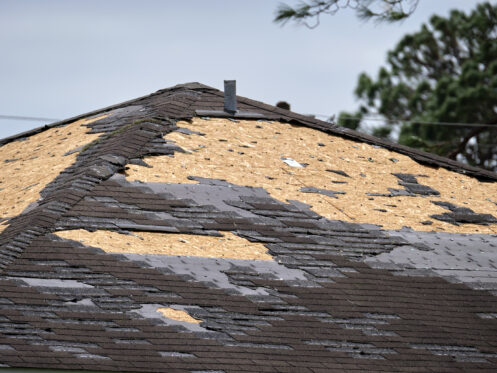Not every storm leaves clear damage behind. Your roof might get knocked around without showing it right away, until a leak shows up or a shingle suddenly goes missing. At HT Roofing & Construction, in Lenexa, KS, we’ve seen how small damage can turn into a larger repair if it’s not caught early.
Look for What’s Out of Place First
After a storm rolls through, your roof might look all right at a glance, but a closer look can tell a different story. Start by walking around your yard or driveway and checking for things that don’t belong. A shingle lying in the grass, bits of black granules in your gutters, or a metal piece near the foundation might not mean much by themselves, but they could be the only clues that your roof has a problem.
You don’t have to get on a ladder. From the ground, you can still see if any shingles are curled, missing, or pushed out of line. If parts of your roof look uneven or something seems off, take a closer look. Strong winds can shift things like chimney flashing, leaving them bent or partly detached.
Check Gutters and Downspouts
After a storm, inspect where your downspouts meet the ground. If the water isn’t draining away from your house like it usually does, or if you notice overflow paths in the dirt or mulch, that’s something to pay attention to.
Gutters that pull away from the roof line or sag in the middle may have been pulled away by heavy rain or debris. When leaves, branches, and shingle pieces get stuck up there, it’s easy for the weight to push everything out of place.
Look Inside the House for Hidden Signs
Not all roof problems show up outside. Sometimes the first place you’ll notice damage is inside. A water stain on the ceiling that wasn’t there before or a damp smell in the attic after a storm can be early warnings. You might want to poke your head into the attic with a flashlight and see if you notice anything unusual.
Drips, damp insulation, or light peeking through spots where it shouldn’t can all mean trouble. Even if you don’t go up there often, you’ll be glad you checked. Catching a leak early gives you more options to fix it before it turns into a full-blown repair job.
Keep an Eye on Skylights and Vents
Skylights and roof vents are built to be tough, but they’re also common spots where leaks start after storms. If you have a skylight, watch how the water runs down the glass the next time it rains. If it starts pooling at the base or seeping around the frame, the flashing around it might have shifted.
Roof vents are another one to check, especially if you’ve had strong winds. Bent or rattling vents can open the door to water damage, even if the rest of the roof looks fine. These parts are small, but they make a big impact. A cracked seal or warped cover might not seem like much, but that’s all it takes for moisture to sneak in.
Tree Limbs and Debris Can Cause Hidden Trouble
It’s easy to spot a branch that’s crashed straight through a roof. What’s harder to notice is the slow kind of damage. After a storm, even small limbs that land gently can press into shingles and cause tiny cracks. Over time, those cracks can let water in, especially during the next storm. If you have trees that hang over your roof, pay close attention to that area.
Twigs, leaves, and seed pods can clog valleys and corners where water is supposed to run off. If it sits too long, moisture starts to seep under the shingles. You don’t have to clear everything the second the sun comes back out, but don’t let debris stay up there too long.
Take Pictures Before You Fix Anything
If you do find something that looks like storm damage, take a few photos before you fix it. Even if it seems small, those pictures can help if you end up filing an insurance claim later. Try to get different angles and show any damage in relation to other parts of your home.
Call Us to Check on Your Roof
You don’t need to be a roofer to catch warning signs after a storm; you just need to know where to look and when to ask for help. We also offer skylight installation, gutter repair, and attic ventilation upgrades. If something seems off, it’s worth getting it looked at before the next storm rolls through. Schedule a full inspection or roof repair today with HT Roofing & Construction.
